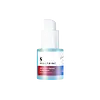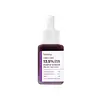What's inside
What's inside
 Key Ingredients
Key Ingredients

 Benefits
Benefits

 Concerns
Concerns

 Ingredients Side-by-side
Ingredients Side-by-side

Water
Skin ConditioningArtemisia Vulgaris Extract
Skin ConditioningAloe Barbadensis Leaf Extract
EmollientGlycolic Acid
BufferingCalendula Officinalis Flower Extract
MaskingMethyl Gluceth-10
EmulsifyingSodium Hydroxide
BufferingDipropylene Glycol
HumectantPentylene Glycol
Skin ConditioningBetaine
HumectantSalicylic Acid
Masking1,2-Hexanediol
Skin ConditioningAmylopectin
Dextrin
AbsorbentXanthan Gum
EmulsifyingSodium Hyaluronate
HumectantGlycerin
HumectantAllantoin
Skin ConditioningPanthenol
Skin ConditioningMelia Azadirachta Leaf Extract
Skin ConditioningEthylhexylglycerin
Skin ConditioningMelia Azadirachta Flower Extract
Skin ConditioningAmino Esters-1
Skin ConditioningPolyquaternium-51
Skin ConditioningTrisodium Ethylenediamine Disuccinate
Dipotassium Glycyrrhizate
HumectantCoccinia Indica Fruit Extract
Skin ConditioningButylene Glycol
HumectantSolanum Melongena Fruit Extract
Skin ConditioningAloe Barbadensis Flower Extract
EmollientOctanediol
Curcuma Longa Root Extract
MaskingOcimum Basilicum Flower/Leaf Extract
TonicPearl Powder
Lawsonia Inermis Flower/Fruit/Leaf Extract
MaskingOcimum Sanctum Leaf Extract
Skin ConditioningTocopherol
AntioxidantWater, Artemisia Vulgaris Extract, Aloe Barbadensis Leaf Extract, Glycolic Acid, Calendula Officinalis Flower Extract, Methyl Gluceth-10, Sodium Hydroxide, Dipropylene Glycol, Pentylene Glycol, Betaine, Salicylic Acid, 1,2-Hexanediol, Amylopectin, Dextrin, Xanthan Gum, Sodium Hyaluronate, Glycerin, Allantoin, Panthenol, Melia Azadirachta Leaf Extract, Ethylhexylglycerin, Melia Azadirachta Flower Extract, Amino Esters-1, Polyquaternium-51, Trisodium Ethylenediamine Disuccinate, Dipotassium Glycyrrhizate, Coccinia Indica Fruit Extract, Butylene Glycol, Solanum Melongena Fruit Extract, Aloe Barbadensis Flower Extract, Octanediol, Curcuma Longa Root Extract, Ocimum Basilicum Flower/Leaf Extract, Pearl Powder, Lawsonia Inermis Flower/Fruit/Leaf Extract, Ocimum Sanctum Leaf Extract, Tocopherol
Water
Skin ConditioningGlycolic Acid
BufferingCentella Asiatica Extract
CleansingGluconolactone
Skin ConditioningGlycerin
HumectantSodium Hydroxide
BufferingButylene Glycol
HumectantPanthenol
Skin ConditioningSalicylic Acid
MaskingPotassium Azeloyl Diglycinate
Skin ConditioningTasmannia Lanceolata Fruit/Leaf Extract
AntioxidantBiosaccharide Gum-1
HumectantDaucus Carota Sativa Extract
PerfumingVaccinium Myrtillus Bud Extract
AntioxidantAllantoin
Skin ConditioningDipotassium Glycyrrhizate
HumectantXanthan Gum
EmulsifyingAmylopectin
Dextrin
AbsorbentBenzotriazolyl Dodecyl P-Cresol
UV AbsorberChlorphenesin
AntimicrobialTetrasodium EDTA
Maltodextrin
AbsorbentPhenoxyethanol
PreservativeCitric Acid
Buffering1,2-Hexanediol
Skin ConditioningPotassium Sorbate
PreservativeEthylhexylglycerin
Skin ConditioningCI 42090
Cosmetic ColorantWater, Glycolic Acid, Centella Asiatica Extract, Gluconolactone, Glycerin, Sodium Hydroxide, Butylene Glycol, Panthenol, Salicylic Acid, Potassium Azeloyl Diglycinate, Tasmannia Lanceolata Fruit/Leaf Extract, Biosaccharide Gum-1, Daucus Carota Sativa Extract, Vaccinium Myrtillus Bud Extract, Allantoin, Dipotassium Glycyrrhizate, Xanthan Gum, Amylopectin, Dextrin, Benzotriazolyl Dodecyl P-Cresol, Chlorphenesin, Tetrasodium EDTA, Maltodextrin, Phenoxyethanol, Citric Acid, 1,2-Hexanediol, Potassium Sorbate, Ethylhexylglycerin, CI 42090
Ingredients Explained
These ingredients are found in both products.
Ingredients higher up in an ingredient list are typically present in a larger amount.
1,2-Hexanediol is a synthetic liquid and another multi-functional powerhouse.
It is a:
- Humectant, drawing moisture into the skin
- Emollient, helping to soften skin
- Solvent, dispersing and stabilizing formulas
- Preservative booster, enhancing the antimicrobial activity of other preservatives
Allantoin is a soothing ingredient known for its protective and moisturizingg properties. Because of this, it is often added to products with strong active ingredients.
Studies show higher concentrations of this ingredient can promote wound healing.
Though it can be derived from the comfrey plant, allantoin is produced synthetically for cosmetic products to ensure purity.
Learn more about AllantoinWe don't have a description for Amylopectin yet.
Butylene Glycol (or BG) is used within cosmetic products for a few different reasons:
Overall, Butylene Glycol is a safe and well-rounded ingredient that works well with other ingredients.
Though this ingredient works well with most skin types, some people with sensitive skin may experience a reaction such as allergic rashes, closed comedones, or itchiness.
Learn more about Butylene GlycolDextrin is used to thicken a product and helps bind ingredients together. It is created from starch and glycogen.
As an emulsifier, dextrin prevents ingredients from separating. This helps elongate a product's shelf life.
Studies show coating UV filters with dextrin prevents these ingredients from being absorbed. This helps UV ingredients last longer on the skin.
Learn more about DextrinDipotassium Glycyrrhizate comes from licorice root.
Extracts of licorice have demonstrated to have antibacterial, anti‐inflammatory, antiviral, antioxidant properties.
One component, glabridin, has extra potent antioxidant and soothing properties. It has also been found to block pigmentation from UVB rays in guinea pigs.
Licorice Root also contains a flavonoid. Flavonoids are a natural substance from in plants. Flavonoids also have antioxidant properties.
Another component, glycyrrhizin, has been found to have anti-inflammatory and antimicrobial benefits. This may make licorice root extract effective at treating acne. However, more research is needed to support this.
Liquiritin is one of the flavone compounds found in licorice. It has been found to help lighten skin by preventing tyrosinase from reacting with tyrosine. When the two react, protein is converted to melanin. Melanin is the substance in your body that gives your features pigmentation.
Licorice root is native to Southern Europe and Asia. It has been used in traditional Chinese medicine to help with respiratory issues.
Learn more about Dipotassium GlycyrrhizateEthylhexylglycerin (we can't pronounce this either) is commonly used as a preservative and skin softener. It is derived from glyceryl.
You might see Ethylhexylglycerin often paired with other preservatives such as phenoxyethanol. Ethylhexylglycerin has been found to increase the effectiveness of these other preservatives.
Glycerin is already naturally found in your skin. It helps moisturize and protect your skin.
A study from 2016 found glycerin to be more effective as a humectant than AHAs and hyaluronic acid.
As a humectant, it helps the skin stay hydrated by pulling moisture to your skin. The low molecular weight of glycerin allows it to pull moisture into the deeper layers of your skin.
Hydrated skin improves your skin barrier; Your skin barrier helps protect against irritants and bacteria.
Glycerin has also been found to have antimicrobial and antiviral properties. Due to these properties, glycerin is often used in wound and burn treatments.
In cosmetics, glycerin is usually derived from plants such as soybean or palm. However, it can also be sourced from animals, such as tallow or animal fat.
This ingredient is organic, colorless, odorless, and non-toxic.
Glycerin is the name for this ingredient in American English. British English uses Glycerol/Glycerine.
Learn more about GlycerinGlycolic Acid is arguably the most famous alpha hydroxy acid (AHA) with tons of research backing its benefits.
It is found naturally in sugar cane but the form used in skincare is usually synthetic for purity and stability.
Glycolic acid removes the top layer of dead skin cells to allow newer and fresher ones to emerge.
AHAs work by breaking down the structural “glue” that holds old skin cells in place. When that buildup is gone, your skin can renew itself more efficiently.
Research also shows glycolic acid stimulates collagen production, helping to firm and thicken the skin over time. This is one of its biggest advantages over other AHAs.
Overall, glycolic acid helps with:
Fun fact: Glycolic acid boosts skin hydration by helping it produce molecules that increase hyaluronic acid naturally.
To work best, glycolic acid products should have a pH between 3-4 (that’s where exfoliation is most effective but still gentle on skin).
The pH and concentration of a product are key to its effectiveness:
It is normal to feel a slight stinging sensation when using glycolic acid. This usually fades as your skin adjusts.
Because glycolic acid has the smallest molecular size in the AHA family, it can penetrate deeper, which enhances its effectiveness but also makes it more likely to irritate sensitive skin.
If your skin is very sensitive or prone to rosacea, glycolic acid may be too strong; in that case, try milder options like lactic acid or a PHA instead.
Recent studies suggest glycolic acid might even help protect against UV damage. But don’t skip sunscreen! Freshly exfoliated skin is more sensitive to the sun.
Glycolic acid is a skincare superstar. It smooths, brightens, hydrates, and firms the skin. Unless you’re highly sensitive, it’s well worth adding to your routine.
Read more about some other popular AHA's here:
Learn more about Glycolic AcidPanthenol is a common ingredient that helps hydrate and soothe the skin. It is found naturally in our skin and hair.
There are two forms of panthenol: D and L.
D-panthenol is also known as dexpanthenol. Most cosmetics use dexpanthenol or a mixture of D and L-panthenol.
Panthenol is famous due to its ability to go deeper into the skin's layers. Using this ingredient has numerous pros (and no cons):
Like hyaluronic acid, panthenol is a humectant. Humectants are able to bind and hold large amounts of water to keep skin hydrated.
This ingredient works well for wound healing. It works by increasing tissue in the wound and helps close open wounds.
Once oxidized, panthenol converts to pantothenic acid. Panthothenic acid is found in all living cells.
This ingredient is also referred to as pro-vitamin B5.
Learn more about PanthenolSalicylic Acid (also known as beta hydroxy acid or BHA) is a well-known ingredient for treating skin that struggles with acne and clogged pores. It exfoliates both the skin's surface and deep within the pores to help clear out buildup, control oil, and reduce inflammation.
Unlike AHAs (alpha hydroxy acids), salicylic acid is oil-soluble. This allows it to penetrate into pores which makes it especially effective for treating blackheads and preventing future breakouts.
Salicylic acid is also known for its soothing properties. It has a similar structure to aspirin and can calm inflamed or irritated skin, making it a good option for acne-prone skin that is also sensitive.
Concentrations of 0.5-2% are recognized by the U.S. FDA as an over-the-counter topical acne product.
It can cause irritation and/or dryness if one's skin already has a compromised moisture barrier, so it's best to focus on repairing that before introducing this ingredient into your routine.
While salicylic acid does not increase sun sensitivity, it’s still important to wear sunscreen daily to protect your skin.
If you are looking for the ingredient called BHA or Butylated Hydroxyanisole, click here.
Learn more about Salicylic AcidSodium Hydroxide is also known as lye or caustic soda. It is used to adjust the pH of products; many ingredients require a specific pH to be effective.
In small amounts, sodium hydroxide is considered safe to use. However, large amounts may cause chemical burns due to its high alkaline.
Your skin has a natural pH and acid mantle. This acid mantle helps prevent harmful bacteria from breaking through. The acid mantle also helps keep your skin hydrated.
"Alkaline" refers to a high pH level. A low pH level would be considered acidic.
Learn more about Sodium HydroxideWater. It's the most common cosmetic ingredient of all. You'll usually see it at the top of ingredient lists, meaning that it makes up the largest part of the product.
So why is it so popular? Water most often acts as a solvent - this means that it helps dissolve other ingredients into the formulation.
You'll also recognize water as that liquid we all need to stay alive. If you see this, drink a glass of water. Stay hydrated!
Learn more about WaterXanthan gum is used as a stabilizer and thickener within cosmetic products. It helps give products a sticky, thick feeling - preventing them from being too runny.
On the technical side of things, xanthan gum is a polysaccharide - a combination consisting of multiple sugar molecules bonded together.
Xanthan gum is a pretty common and great ingredient. It is a natural, non-toxic, non-irritating ingredient that is also commonly used in food products.
Learn more about Xanthan Gum